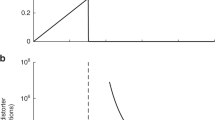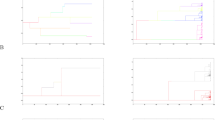Abstract
Arising from: G. Wild, A. Gardner & S. A. West Nature 459, 983–986 (2009)10.1038/nature08071; Wild, Gardner & West reply
Wild et al.1 argue that the evolution of reduced virulence can be understood from the perspective of inclusive fitness, obviating the need to evoke group selection as a contributing causal factor. Although they acknowledge the mathematical equivalence of the inclusive fitness and multilevel selection approaches, they conclude that reduced virulence can be viewed entirely as an individual-level adaptation by the parasite1. Here we show that their model is a well-known special case of the more general theory of multilevel selection, and that the cause of reduced virulence resides in the opposition of two processes: within-group and among-group selection. This distinction is important in light of the current controversy among evolutionary biologists in which some continue to affirm that natural selection centres only and always at the level of the individual organism or gene, despite mathematical demonstrations that evolutionary dynamics must be described by selection at various levels in the hierarchy of biological organization.
This is a preview of subscription content, access via your institution
Access options
Subscribe to this journal
Receive 51 print issues and online access
$199.00 per year
only $3.90 per issue
Buy this article
- Purchase on Springer Link
- Instant access to full article PDF
Prices may be subject to local taxes which are calculated during checkout
Similar content being viewed by others
References
Wild, G., Gardner, A. & West, S. A. Adaptation and the evolution of parasite virulence in a connected world. Nature 459, 983–986 (2009)
Price, G. R. Selection and covariance. Nature 227, 520–521 (1970)
Frank, S. A. Models of parasite virulence. Q. Rev. Biol. 71, 37–78 (1996)
Hamilton, W. D. in Biosocial Anthropology (ed. Fox, R.) 133–155 (Malaby Press, 1975)
Bijma, P. & Wade, M. J. The joint effects of kin, multilevel selection and indirect genetic effects on response to genetic selection. J. Evol. Biol. 21, 1175–1188 (2008)
Hölldobler, B. & Wilson, E. O. The Superorganism: The Beauty, Elegance, and Strangeness of Insect Societies 35 (Norton, 2009)
Muir, W. M. Group selection for adaptation to multiple-hen cages: selection program and direct responses. Poult. Sci. 75, 447–458 (1996)
Ester, E. Genetics of Survival in Cannibalistic Laying Hens. PhD thesis, Wageningen Univ. (2009)
Werfel, J. & Bar-Yam, Y. The evolution of reproductive restraint through social communication. Proc. Natl Acad. Sci. USA 101, 11019–11024 (2004)
Goodnight, C. et al. Evolution in spatial predator-prey models and the “prudent predator”: The inadequacy of steady-state organism fitness and the concept of individual and group selection. Complexity 13, 23–44 (2008)
Durrett, R. & Levin, S. The importance of being discrete (and spatial). Theor. Popul. Biol. 46, 363–394 (1994)
Author information
Authors and Affiliations
Ethics declarations
Competing interests
The authors declare no competing financial interests
Rights and permissions
About this article
Cite this article
Wade, M., Wilson, D., Goodnight, C. et al. Multilevel and kin selection in a connected world. Nature 463, E8–E9 (2010). https://doi.org/10.1038/nature08809
Received:
Accepted:
Issue Date:
DOI: https://doi.org/10.1038/nature08809
This article is cited by
-
Explaining the Cultural Evolution of large-scale Collaboration: Conventionality as an Alternative for Collective Intentionality
Review of Philosophy and Psychology (2023)
-
Moving Past Conventionalism About Multilevel Selection
Erkenntnis (2023)
-
The Evolution of Ecosystem Phenotypes
Biological Theory (2020)
-
Rotating the Necker cube: A bioeconomic approach to cooperation and the causal role of synergy in evolution
Journal of Bioeconomics (2013)
-
Evolutionary molecular medicine
Journal of Molecular Medicine (2012)
Comments
By submitting a comment you agree to abide by our Terms and Community Guidelines. If you find something abusive or that does not comply with our terms or guidelines please flag it as inappropriate.



